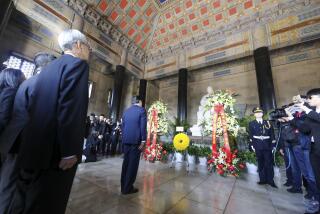Imperial Tomb Buried by Lack of Funds
- Share via
XIAN, China — The ceiling is reputedly studded with pearls, polished to represent stars in an inky night sky. Liquid mercury sluices through a maze of trenches carved into the floor, rivers in a giant relief map of the vast Chinese empire. If ancient accounts are to be believed, this is just part of the splendor of the enormous tomb of Qin Shihuangdi, the first man to rule over a unified China 2,200 years ago.
As head of the small band of archeologists working on Qin’s grave site here, Yuan Zhongyi is eager to find out if such tales are true. “We won’t say so ourselves till we see it,” says Yuan, an amiable man who evinces a scientist’s skepticism.
Unfortunately, the answer may not come for years or even decades, because excavation of what is possibly the biggest treasure trove in China has now ground to a halt. Although archeologists are still toiling at the nearby pits containing China’s famed terra cotta warriors--the vast army of life-size clay soldiers that Qin ordered up to accompany him to the nether world--work on the emperor’s mausoleum itself has been hamstrung by a scarcity of money and scientific know-how.
What most concerns experts like Yuan is the lack of reliable technology for preserving fragile artifacts that have sat untouched for two millenniums inside the tomb, especially items fashioned out of silk and wood.
At various digs around China, a nation rich with history hidden underground, delicate objects have fallen to pieces when moved by even the most deft of hands. In one Han dynasty tomb, some fresh-looking ancient peaches, upon exposure to air, rotted almost instantly and before excavators could photograph them.
“Until we can find the best way to protect [such artifacts], it’s better to leave them in the ground,” says Yuan, who also serves as the director of the museum housing the terra cotta troops.
Experts estimate that there may be as many as 8,000 terra cotta figures when the site is fully excavated. Even then, the soldiers, each wearing a different face and expression, constitute just a fraction of the bounty believed buried with Qin in his vast funerary complex, encompassing a wider area than the tomb alone. All told, Yuan estimates that Qin’s burial ground sprawls over 20 square miles, only a fifth of which has been uncovered.
Ancient sources describe how Qin (pronounced Chin), whose dynasty gave us the word “China,” began constructing his mausoleum almost immediately after ascending the throne as a regional king in 247 BC. (He unified China’s warring factions 25 years later, standardizing language, currency, weights and measures.) The mausoleum required the labor of 700,000 workers, who created an underground city patterned after the imperial capital, Xianyang, northwest of present-day Xian.
Besides the terra cotta warriors, there were opulent fittings such as the pearl-strewn ceiling, records and legends say. Crossbows were set up as booby-traps to automatically fire arrows at intruders to the tomb, which records indicate was plundered just once, not long after Qin died. “There were thieves, but they never reached the center” of the mausoleum, Yuan says.
Yuan’s team operates on a bare-bones budget funded by proceeds from the museum, the lion’s share of which goes toward upkeep and continued excavation of the terra cotta soldiers. A mere $25,000 out of $2.5 million a year is applied to the excavation of the inner tomb, though Yuan would like the allotment to increase tenfold. The government, Yuan says, contributes nothing.
“China is different from Western countries, where enterprises and foundations would support projects like this. China doesn’t have such institutions,” he says. “We’re still a poor country.”
The project welcomes foreign aid and expertise, Yuan says. But privately, some officials speak of reluctance by an overly protective government to allow in foreign archeologists, preferring to import their money and technology but to leave the work to native scholars.
Chinese archeologists have unearthed priceless artifacts around the perimeter of the mausoleum. Their finds include the gorgeous (horses and chariots made of bronze) and the gruesome (remains of seven young people in smaller graves, believed to be Qin’s sons and daughters, killed by a power-hungry sibling who had them decapitated or hacked in half).
But until more money and technology become available, the grave site will probably remain an unprepossessing hill here in central China. “Everybody wants to know what’s inside. . . . This is an archeologist’s paradise,” says Yuan, who at 60 is nearing retirement. “But I won’t be the one to do it.”
More to Read
Sign up for Essential California
The most important California stories and recommendations in your inbox every morning.
You may occasionally receive promotional content from the Los Angeles Times.














